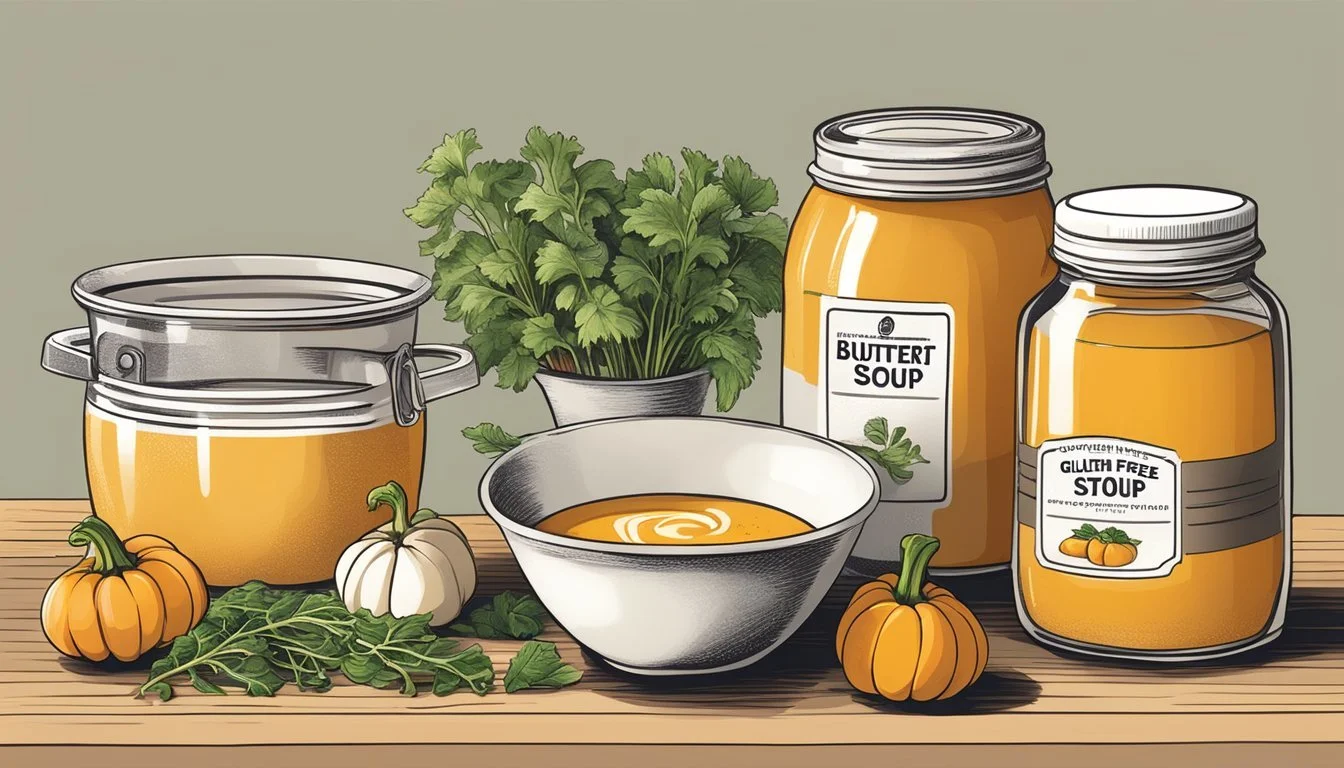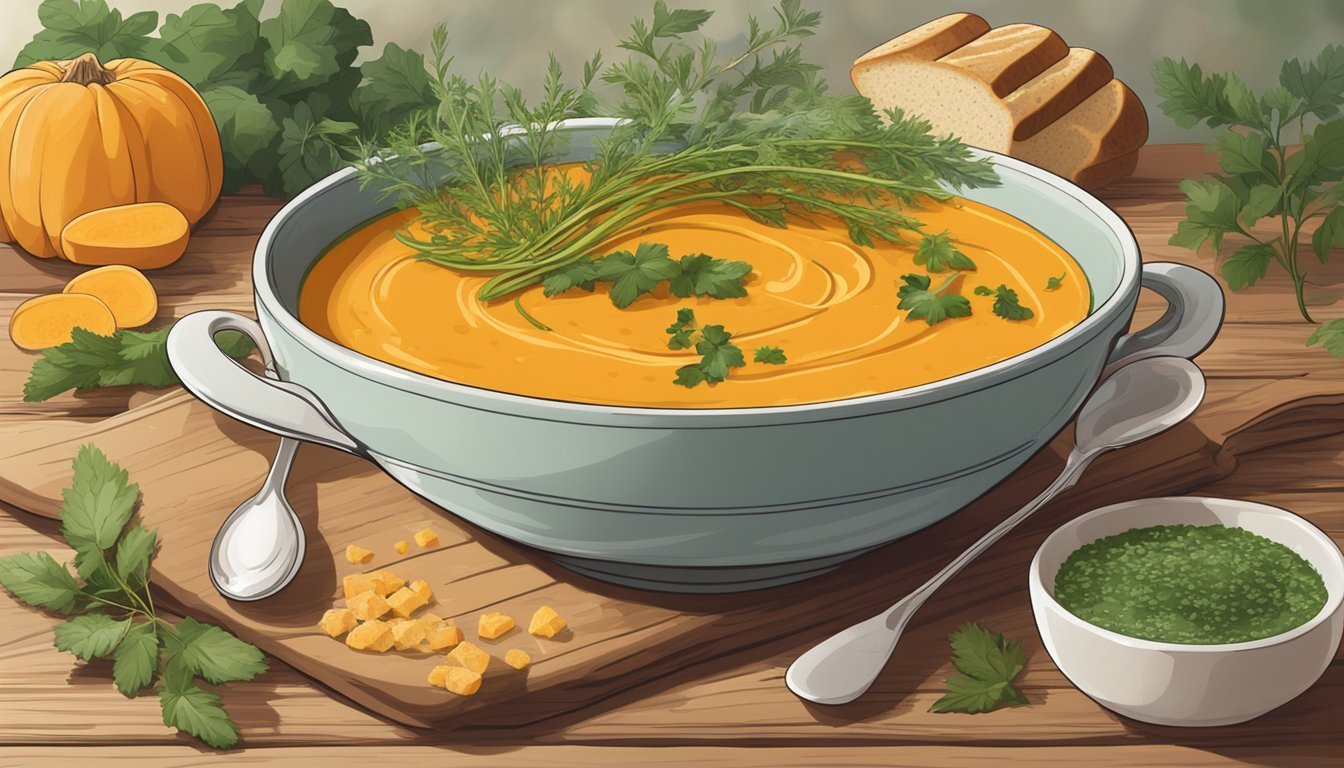How Long Does Gluten-Free Butternut Squash Soup Last?
Storage Tips and Shelf Life
Butternut squash soup is a comforting and nutritious dish that can be made gluten-free. For those who enjoy meal prepping or cooking in batches, it is essential to know how long this delicious soup can be stored safely. Properly stored, gluten-free butternut squash soup can last up to 3-4 days in the refrigerator.
If you are looking to keep your soup for a longer period, freezing is also an option. Stored in an airtight container, it can be frozen for up to three months without losing its quality. This makes butternut squash soup an excellent choice for those who want to enjoy a healthy meal that is ready to go.
To ensure the best quality and safety of the soup, always check for signs of spoilage before consuming any leftovers. With proper storage techniques, you can enjoy the rich, soothing flavors of butternut squash soup whenever you desire.
Understanding Gluten-Free Soups
Gluten-free soups, especially those made from butternut squash, offer a nutritious and delicious option for individuals with gluten intolerance or celiac disease. Knowing what makes a soup gluten-free is essential for maintaining a diet that supports health and well-being.
Defining Gluten-Free
Gluten is a protein found in wheat, barley, and rye. Gluten-free soups must exclude these ingredients to be suitable for those with celiac disease or gluten sensitivity. Ingredients need to be carefully selected and handled to avoid cross-contamination.
Common substitutes for gluten-containing thickeners include cornstarch, arrowroot, and potato starch. Using fresh vegetables, herbs, and spices ensures the soup is both safe and flavorful without compromising nutrition.
Adopting a gluten-free diet might be challenging, but understanding the basics helps maintain flavor and variety in meal choices while ensuring it meets dietary needs. This approach fosters wellness and helps manage adverse reactions associated with gluten consumption.
Ingredients Spotlight
Each ingredient plays a crucial role in creating the rich, flavorful profile of gluten-free butternut squash soup. Highlighting the key components, from the squash itself to the spices that enhance its sweetness, brings out the full potential of this comforting dish.
Primary Ingredients
Butternut Squash: The foundational element, its naturally sweet and nutty flavor is intensified through roasting or simmering. It is rich in vitamins A and C.
Olive Oil: Used for sautéing and roasting, it adds a subtle fruity flavor and helps to soften the vegetables.
Onion and Garlic: These aromatics provide a depth of flavor when sautéed, creating a savory base that balances the sweetness of the squash.
Vegetable Broth: A must for adding body and a savory depth to the soup. Ensure it's gluten-free.
Seasoning and Spices
Salt and Black Pepper: Essential for enhancing the natural flavors of the ingredients without overpowering them. Start with a small amount and adjust to taste.
Nutmeg and Cloves: These warm spices complement the sweetness of the butternut squash and add a subtle complexity. Use sparingly to avoid overwhelming the dish.
Cayenne: Adds a hint of heat and depth, balancing the sweetness of the squash. Use cautiously, especially if serving to those sensitive to spice.
Additional Flavor Enhancers
Carrots and Sweet Potatoes: They introduce additional layers of sweetness and texture, making the soup more hearty and complex.
Coconut Milk: A popular addition for those seeking a dairy-free option. It brings a creamy texture and a slight sweetness that complements the squash.
Herbs: Fresh or dried thyme and parsley can elevate the soup with their bright, earthy notes. Add at the end of cooking to retain their freshness.
Incorporating a well-rounded selection of spices and flavor enhancers can transform butternut squash soup into a memorable dish, satisfying and warming for any occasion.
Preparation Techniques
Proper techniques ensure the best flavor and texture for gluten-free butternut squash soup. Critical methods include roasting the squash for depth of flavor and using appropriate tools for pureeing to achieve the desired consistency.
Roasting Butternut Squash
Roasting butternut squash enhances its natural sweetness and adds a rich, caramelized flavor to the soup. Start by preheating the oven to 350º F. Peel and cube the squash, then toss it with olive oil, salt, pepper, and optional herbs like thyme and rosemary.
Spread the cubes on a lightly greased baking sheet in a single layer. Roast for 25-30 minutes or until tender and slightly browned at the edges. Using this method intensifies the squash's flavor, which is crucial for a rich and delicious soup.
Pureeing Soups
Achieving a smooth texture is essential for butternut squash soup. A blender or immersion blender works well, with the immersion blender being particularly convenient for direct use in the pot. Alternatively, a food processor or stick blender can be used, working in batches if necessary.
For a chunkier texture, a potato masher can break down the squash after cooking. When using a traditional blender, be sure to let the mixture cool slightly before pureeing to avoid splatters. Blend until smooth, then return the soup to the pot and adjust seasonings.
Storage Guidelines
Proper storage is crucial to maintain the quality and safety of gluten-free butternut squash soup. Here, we outline effective techniques for both refrigeration and freezing.
Refrigeration Best Practices
To refrigerate gluten-free butternut squash soup effectively, store it in airtight containers to prevent spoilage and contamination.
The soup should be cooled to room temperature before placing it in the refrigerator, which helps prevent condensation inside the container.
The ideal refrigerator temperature for storing the soup is 40°F (4°C) or below.
Labeling the container with the date of storage ensures that you track freshness accurately. Under optimal conditions, the soup can last 4-5 days in the refrigerator.
If the soup contains cream, verify that it doesn’t separate during storage; frequent stirring can help maintain its consistency.
Freezing and Thawing
Freezing extends the shelf life of gluten-free butternut squash soup up to 3 months. Ensure that the soup has fully cooled before transferring it to airtight, freezer-safe containers, leaving 1-2 inches of headspace for expansion.
For ease of thawing, divide the soup into manageable portions. Label the containers with the date to monitor freshness.
When ready to use, thaw the soup in the refrigerator overnight. If time is limited, a microwave on the defrost setting can expedite the process.
Reheat gently on the stove to maintain the soup's texture and flavor, stirring frequently to reincorporate any separated ingredients, especially if the soup contains cream.
Avoid refreezing once thawed, as this can degrade the quality.
Nutritional Value
Gluten-free butternut squash soup offers a variety of nutrients, contributing significantly to a balanced diet. It contains essential vitamins and minerals that support overall health.
Health Benefits
Butternut squash is rich in vitamins A and C, which are important for immune function and skin health. Vitamin A supports vision and is crucial for growth and development. Vitamin C aids in the repair of body tissues and acts as an antioxidant.
Additionally, this soup is an excellent source of potassium, contributing to heart health and proper muscle function. The dietary fiber in butternut squash helps in digestion and maintaining healthy blood sugar levels. These properties make the soup beneficial for individuals seeking to enhance their nutrient intake.
Macronutrient Breakdown
A serving of gluten-free butternut squash soup typically contains around 100-150 calories. The carbohydrate content is moderate, with approximately 20-25 grams per serving, primarily from the squash itself.
Protein content is modest, usually around 2-3 grams per serving, depending on additional protein sources like broth. Fat content is low, generally around 1-3 grams, making it a low-fat meal option. The soup also provides omega-3 fatty acids if olive oil is used in preparation.
In summary, the balance of macronutrients in this soup offers an energy-dense, nutritious option that aligns well with dietary needs and preferences.
Dietary Considerations
When preparing gluten-free butternut squash soup, dietary restrictions and preferences should be taken into account. Whether the focus is on vegan diets or managing common food allergies, adjustments can be made to suit various needs.
Vegan and Vegetarian Variations
For those who adhere to vegan or vegetarian diets, substituting animal-based ingredients with plant-based options is essential.
To make butternut squash soup vegan, use vegetable broth instead of chicken broth for the base. Non-dairy milk such as coconut milk or cashew milk can provide a creamy texture without using dairy products. These alternatives are also lactose-free, making them suitable for those with lactose intolerance.
Adding additional vegetables like carrots, celery, and sweet potato can enhance flavor and nutritional value. Seasoning with herbs and spices such as thyme, rosemary, and mild curry powder can provide depth to the flavor profile while staying within the vegan and vegetarian guidelines.
Managing Allergies and Sensitivities
When creating gluten-free butternut squash soup for individuals with allergies or sensitivities, careful consideration of ingredients is crucial.
Avoid using common allergens like dairy by opting for dairy-free alternatives such as cashew milk or coconut milk. These substitutes not only replace dairy but also add a rich, creamy texture.
Ensure all spices and broths are certified gluten-free to prevent cross-contamination. It’s also beneficial to check labels for hidden allergens and use fresh, whole ingredients whenever possible. If nuts are an issue, avoid cashew milk and choose other non-nut milk options.
Cooking methods like roasting the butternut squash can concentrate flavors without needing additional potentially allergenic ingredients. It’s important to maintain a clean cooking environment to avoid any unintended exposure to allergens.
Serving Suggestions
Perfecting the flavor of gluten-free butternut squash soup is crucial, but equally important is how you serve it. The right accompaniments and presentation can elevate the entire dining experience.
Choosing the Right Accompaniments
Selecting the right accompaniments enhances the soup’s natural flavors. Garnishes like toasted pumpkin seeds add a delightful crunch and a touch of earthiness. Croutons also provide a pleasant texture contrast, especially when they are gluten-free.
Adding a dollop of sour cream can introduce a creamy, tangy element to the soup. For a subtle onion flavor, finely sliced chives make an excellent garnish. These additions not only improve the taste but also add visual appeal.
Presentation Ideas
Presentation plays a key role in the overall dining experience. Serving the soup in a white porcelain bowl can make the vibrant orange color of the butternut squash stand out. Drizzling a swirl of olive oil or sour cream on the surface before adding garnish can create a visually appealing look.
Croutons and toasted pumpkin seeds can be artfully arranged on top of the soup. Sprinkle finely chopped chives for an added touch of color and flavor. Using elegant soup bowls and appropriate cutlery enhances the overall presentation, making the dish look and feel more inviting.
Enhancing Your Recipe
Adding unique ingredients and adjusting cooking methods can elevate your gluten-free butternut squash soup to a new level. Focus on experimenting with flavor combinations and preparation techniques.
Experimenting With Variants
Roasting vs. Boiling:
Roasting the butternut squash before incorporating it into the soup enhances its natural sweetness and adds a rich, caramelized flavor. Use a lined baking tray, drizzle with olive oil, season, and roast at 180°C for 45 minutes.
Boiling keeps the soup lighter and is quicker. Add cubed squash, onions, carrots, and celery to boiling water or broth, then season with salt, pepper, thyme, and rosemary.
Flavor Enhancements:
Spices like mild curry powder can be incorporated to give the soup a warm and earthy aroma. Add it to sautéed garlic and onions before combining with the rest of the ingredients.
Herbs such as thyme and rosemary can provide depth. Add these early in the cooking process so their flavors can meld.
Texture Variations:
Blend the soup to achieve a creamy texture. Using a high-speed blender will help incorporate air, making it smooth. Alternatively, leave some chunks of vegetables intact for a rustic feel.
Add Ingredients:
Combine different types of squash like delicata squash. Half of the squash flesh can be blended with the main ingredients to create a complex flavor profile. Integrate fruits like apple, as it complements the sweetness of roasted butternut squash.
Serve With:
Top with roasted pumpkin seeds for crunch. This not only adds texture but also packs in extra nutrients.
Labeling these enhancements allows individuals to personalize their butternut squash soup according to their taste preferences and recipe restrictions, making every bowl unique.








